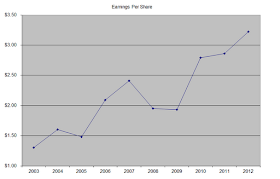Medtronic, Inc. (MDT) manufactures and sells device-based medical therapies worldwide. This dividend champion has paid dividends since 1977 and increased them for 35 years in a row.
The company’s last dividend increase was in June 2012 when the Board of Directors approved a 7.20% increase to 26 cents/share. The company’s largest competitors include Baxter (BAX), Becton Dickinson (BDX) and St Jude Medical (STJ).
Over the past decade this dividend growth stock has delivered an annualized total return of 1.20% to its shareholders.
The company has managed to an impressive increase in annual EPS growth since 2003. Earnings per share have risen by 10.60% per year. Analysts expect Medtronic to earn $3.66 per share in 2013 and $3.85 per share in 2014. In comparison Medtronic earned $3.22/share in 2012.
The company has consistently repurchased stock over the past decade, and has reduced its share count from 1,220 million shares in 2003 to 1,041 million in 2012.
The growth in earnings per share will be achieved by introductions of new devices, cost containment initiatives as well as increase in foreign sales. Some cost containment initiatives that Medtronic had started a few years ago are starting to bear fruit. Another factor that could help EPS growth is the consistent repurchase of stock by the company. New initiatives such as its device to treat abdominal aortic aneurisms with minimal invasive procedures as well as expanding into non-traditional markets, could bolster growth. Last but not least, emerging markets such as China and India could present solid opportunities for growth, as emerging markets in general could deliver double digit percentage increases in sales over the next decade.
The medical equipment market is highly competitive and is characterized by short product life cycles. However, the scale of Medtronic’s operations, its continued investments in innovation as well as its diverse nature of procedures offset some of the risks mentioned in the previous sentence. Another risk that the company faces includes regulatory risk, including a new law which could be initiated in 2013 that would add a 2.30% excise tax on to the sales price of company’s devices.
The return on equity has largely remained between 19% and 23%, with the exception of a brief spike in 2006 – 2007 period. Rather than focus on absolute values for this indicator, I generally want to see at least a stable return on equity over time.
The annual dividend payment has increased by 15.80% per year over the past decade, which is higher than the growth in EPS. The expansion in the dividend payout ratio allowed the company to raise distributions at a rate that is higher than earnings.
A 16% growth in distributions translates into the dividend payment doubling almost every four and a half years. If we look at historical data, going as far back as 1978 we see that Medtronic has actually managed to double its dividend every four years on average.
The dividend payout ratio increased from 19% in 2003 to 30% in 2012. A lower payout is always a plus, since it leaves room for consistent dividend growth minimizing the impact of short-term fluctuations in earnings.
Currently, Medtronic is attractively valued at 11.70 times earnings, has an adequately covered dividend and yields 2.70%. I would consider adding to my position in the stock subject to availability of funds.
Full Disclosure: Long MDT
Relevant Articles:
- Seven Stocks Boosting Investor Payouts
- The Lost Decade: Opportunity of a Lifetime for Dividend Investors
- 17 Cheap Dividend Aristocrats on Sale
- Becton, Dickinson and Company (BDX) Dividend Stock Analysis




